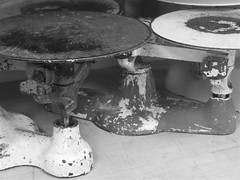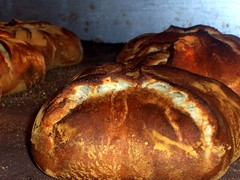Steps as a Successful Baker :
- Have Balanced Formulas
--- A collection of formulas that work
--- Formulas you have tried out in your bakery & changed to suit your needs
--- Be a Control Freak
--- Have Consistency every time!
--- Know Functions of Ingredients in your formulas, so as to predict the outcome.
-Know Proper Mixing
[1st speed]
--- Remember your Goal is Consistency
--- know that To Control consistency, hold back water.
--- Know NEVER to control mix with flour!
--> Gluten Development
[2nd speed]
--- know Proper gluten development VERY important, if dough is mixed too long gluten will separate.
*know your 3 main types of mix:
[Short ] {uneven gluten, tears window}
Uneven Window

[Intensive] { not quite a window, small tears}
[Improved] {fully developed window, feels like skin}
Fully Developed Window

{
To check for the development of your dough :
- Stop mixer, tug on a piece of dough {always from the bottom, due to more consistent mix} You will feel an elastic feel the longer you mix.
- Take out the piece of dough. Start pulling from the bottom of your dough piece Until it is very thin in the middle & forms a window. Let the dough get pliable in your hands -- do not force the stretch.
- Hold on sides, & hold up the "window" to the light. You will see the gluten will form "strands" criss-crossing in your dough like a crude mesh , as it starts to develop.
- Gently touch with a finger - if it is taught, the dough is ready for the next step}
- Know Fermentation
{note : artisan bread doughs have longer fermentation}--- Longer fermentation means shorter mixing.
--- Gluten is modified {Acidity = Flavor}
[ Dough Temperature] [completion of mixing]
{ Best environment for fermentation is 50°F & 80% humidity. Dough doesn't ferment well under 40° F}
---78°F - 84°F [can be as low as 74°F]
---If you lower temp. fermentation slows
---If temp is raised fermentation speeds up.
---Remember cool doughs make for the best fermentation.
[ the process of Fermentation ] [alcoholic fermentation starts]
---Remember fermentation starts as soon as mixer stops.
---This is the MOST important part of bread making
---Gluten is biochemically modified
---improved stretchability
---improved elasticity
---Carbon dioxide gas is produced
---Acidity
-When Scaling out dough
{an efficient experienced baker can handle 8 gal at a time}
---You should never scale out more dough than you can handle in 15-20 minutes. Or dough will ferment further while sitting & product will be nonuniform[larger] .
-Tips for Rounding & Shaping
{ Additional Gluten development = mix + folding (bench work) }
---Pre-shaping
---Cover after pre-shape or "crust" will develop
- Intermediate Proof or Bench Time
---The time when dough has been rounded & now resting under plastic.
- Molding & Shaping
---Flatten dough rounds out to expel gas
---Shape into final loaf
- Panning
Mise en place :
---boards
---Strap pans
---Serrated sheet pans
{ seams must be bottom down to prevent splitting of loaf while baking}
-Proofing
---Put into a Proof Box, steamer.
---Almost the last fermentation.
---95°F -98°F , 80% humidity
---Proof according to product
---don't let dry out
---Touch
{Finger imprint test
- Lightly tap the top of a loaf in the proofer-- Finger should stay imprinted in dough if proofed enough
- If proofed too long/not enough you can't repair dough.
- Over proofed dough can be put into a hotter oven to try & kill yeast immediately. To save product}








































Please stop by to see my latest template upgrade, I promise it won't disapoint! After recoding and tweaking --- I think I am finally happy now.
Today we had a winter storm...the snow was blowing sideways...brrrrr!
I have been doing alot of pondering, more specifically along the lines of "Pay it forward"; If America or the World ever needed this concept--- they definetly could use it NOW!
I am thinking about all the practically nameless people, who have connected with me, in the vast cyber universe.
I browse their webpages,tinged with subtle clues from their non-cyber lives --- proof of an outside world.
Touched by the words on glowing page, after glowing page. A testament to human emotion. Sheding light on our own disablities or insecurities; making a mockery of our own sarcasms.
We are not "the blind leading the blind" , nor our we drifters.
We float on bandwidth --- toggled to our keypads. Clicking link, after ugly colored link.
Seeking out the most current and relative information.
Until our eyes strain, our heads fall heavy....overrun with the immaterial.